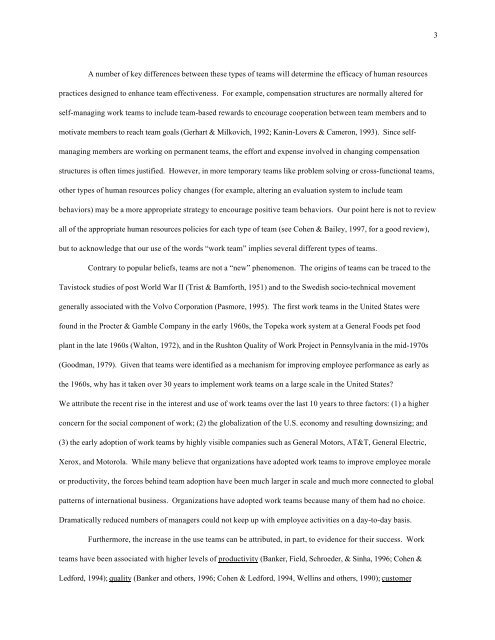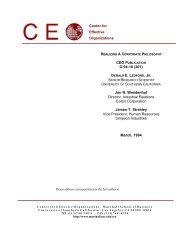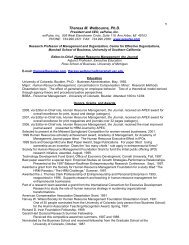Our Past, Present, and Future in Teams - Center for Effective ...
Our Past, Present, and Future in Teams - Center for Effective ...
Our Past, Present, and Future in Teams - Center for Effective ...
Create successful ePaper yourself
Turn your PDF publications into a flip-book with our unique Google optimized e-Paper software.
3A number of key differences between these types of teams will determ<strong>in</strong>e the efficacy of human resourcespractices designed to enhance team effectiveness. For example, compensation structures are normally altered <strong>for</strong>self-manag<strong>in</strong>g work teams to <strong>in</strong>clude team-based rewards to encourage cooperation between team members <strong>and</strong> tomotivate members to reach team goals (Gerhart & Milkovich, 1992; Kan<strong>in</strong>-Lovers & Cameron, 1993). S<strong>in</strong>ce selfmanag<strong>in</strong>gmembers are work<strong>in</strong>g on permanent teams, the ef<strong>for</strong>t <strong>and</strong> expense <strong>in</strong>volved <strong>in</strong> chang<strong>in</strong>g compensationstructures is often times justified. However, <strong>in</strong> more temporary teams like problem solv<strong>in</strong>g or cross-functional teams,other types of human resources policy changes (<strong>for</strong> example, alter<strong>in</strong>g an evaluation system to <strong>in</strong>clude teambehaviors) may be a more appropriate strategy to encourage positive team behaviors. <strong>Our</strong> po<strong>in</strong>t here is not to reviewall of the appropriate human resources policies <strong>for</strong> each type of team (see Cohen & Bailey, 1997, <strong>for</strong> a good review),but to acknowledge that our use of the words “work team” implies several different types of teams.Contrary to popular beliefs, teams are not a “new” phenomenon. The orig<strong>in</strong>s of teams can be traced to theTavistock studies of post World War II (Trist & Bam<strong>for</strong>th, 1951) <strong>and</strong> to the Swedish socio-technical movementgenerally associated with the Volvo Corporation (Pasmore, 1995). The first work teams <strong>in</strong> the United States werefound <strong>in</strong> the Procter & Gamble Company <strong>in</strong> the early 1960s, the Topeka work system at a General Foods pet foodplant <strong>in</strong> the late 1960s (Walton, 1972), <strong>and</strong> <strong>in</strong> the Rushton Quality of Work Project <strong>in</strong> Pennsylvania <strong>in</strong> the mid-1970s(Goodman, 1979). Given that teams were identified as a mechanism <strong>for</strong> improv<strong>in</strong>g employee per<strong>for</strong>mance as early asthe 1960s, why has it taken over 30 years to implement work teams on a large scale <strong>in</strong> the United States?We attribute the recent rise <strong>in</strong> the <strong>in</strong>terest <strong>and</strong> use of work teams over the last 10 years to three factors: (1) a higherconcern <strong>for</strong> the social component of work; (2) the globalization of the U.S. economy <strong>and</strong> result<strong>in</strong>g downsiz<strong>in</strong>g; <strong>and</strong>(3) the early adoption of work teams by highly visible companies such as General Motors, AT&T, General Electric,Xerox, <strong>and</strong> Motorola. While many believe that organizations have adopted work teams to improve employee moraleor productivity, the <strong>for</strong>ces beh<strong>in</strong>d team adoption have been much larger <strong>in</strong> scale <strong>and</strong> much more connected to globalpatterns of <strong>in</strong>ternational bus<strong>in</strong>ess. Organizations have adopted work teams because many of them had no choice.Dramatically reduced numbers of managers could not keep up with employee activities on a day-to-day basis.Furthermore, the <strong>in</strong>crease <strong>in</strong> the use teams can be attributed, <strong>in</strong> part, to evidence <strong>for</strong> their success. Workteams have been associated with higher levels of productivity (Banker, Field, Schroeder, & S<strong>in</strong>ha, 1996; Cohen &Led<strong>for</strong>d, 1994); quality (Banker <strong>and</strong> others, 1996; Cohen & Led<strong>for</strong>d, 1994, Well<strong>in</strong>s <strong>and</strong> others, 1990); customer
















